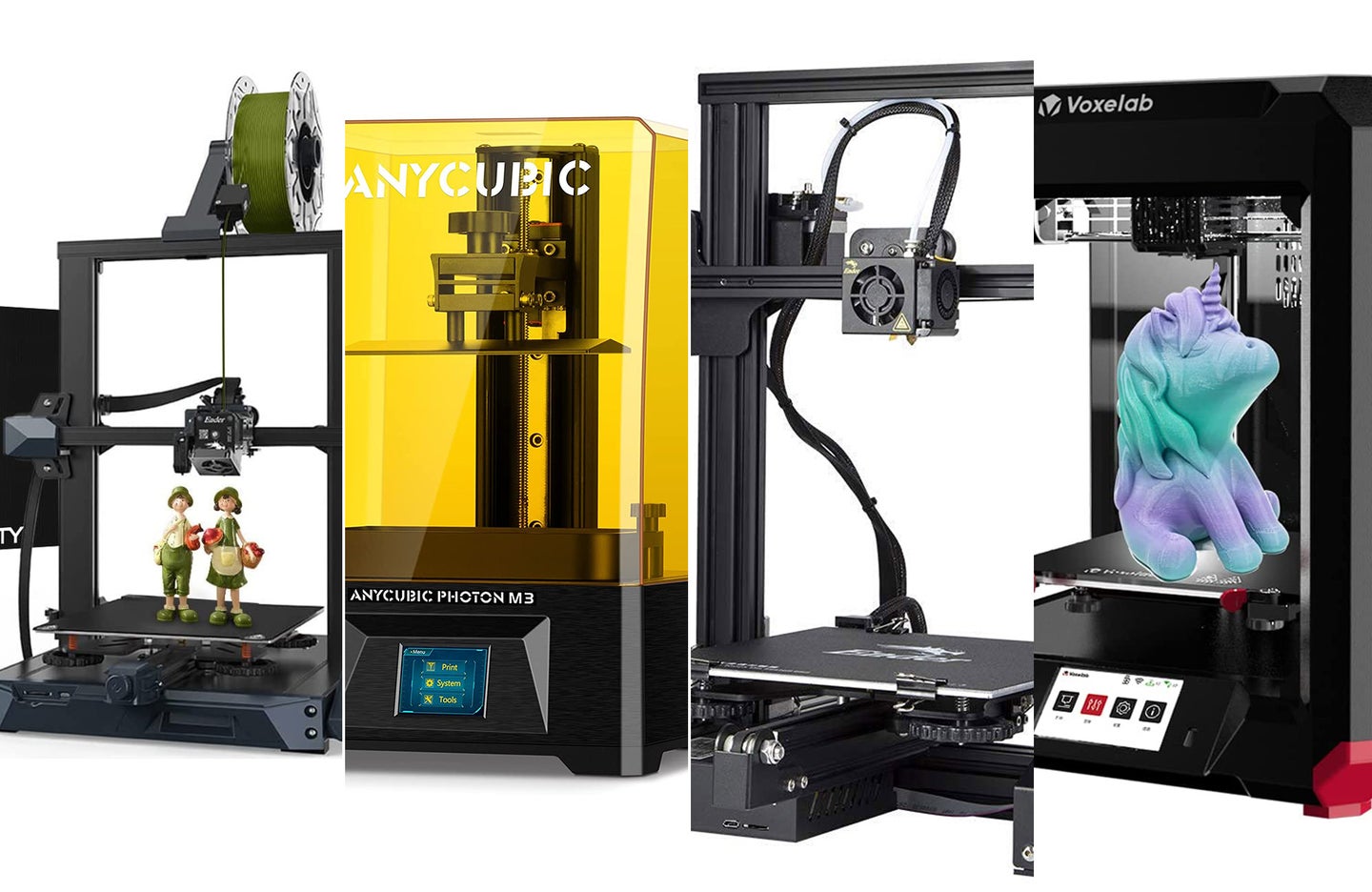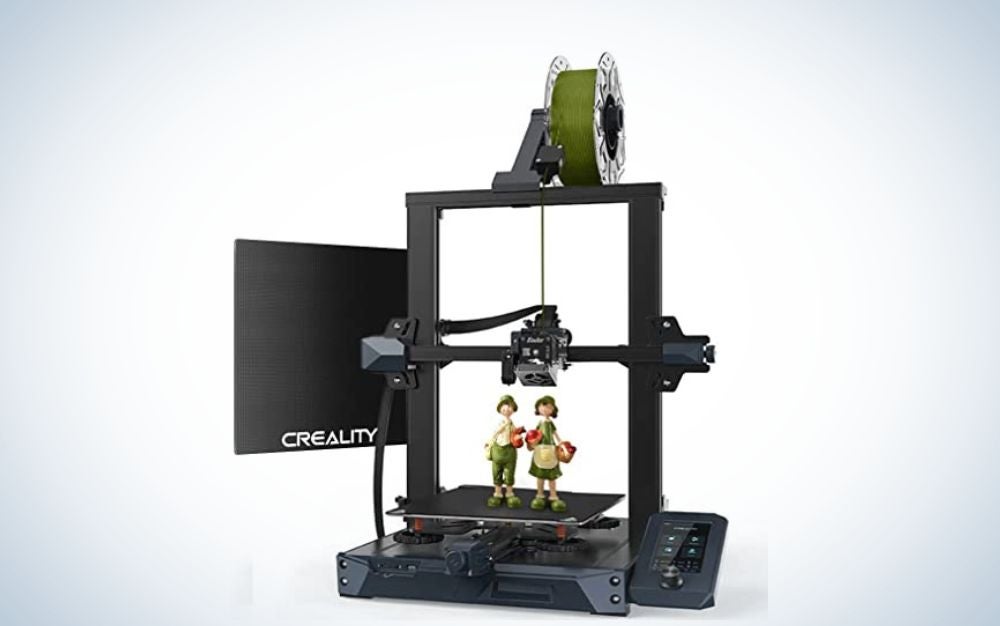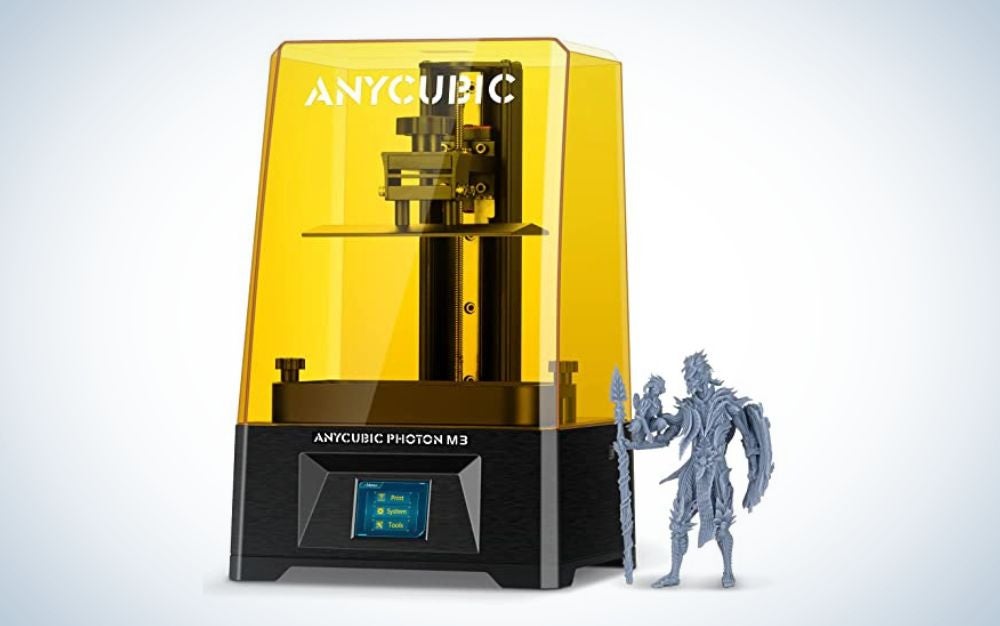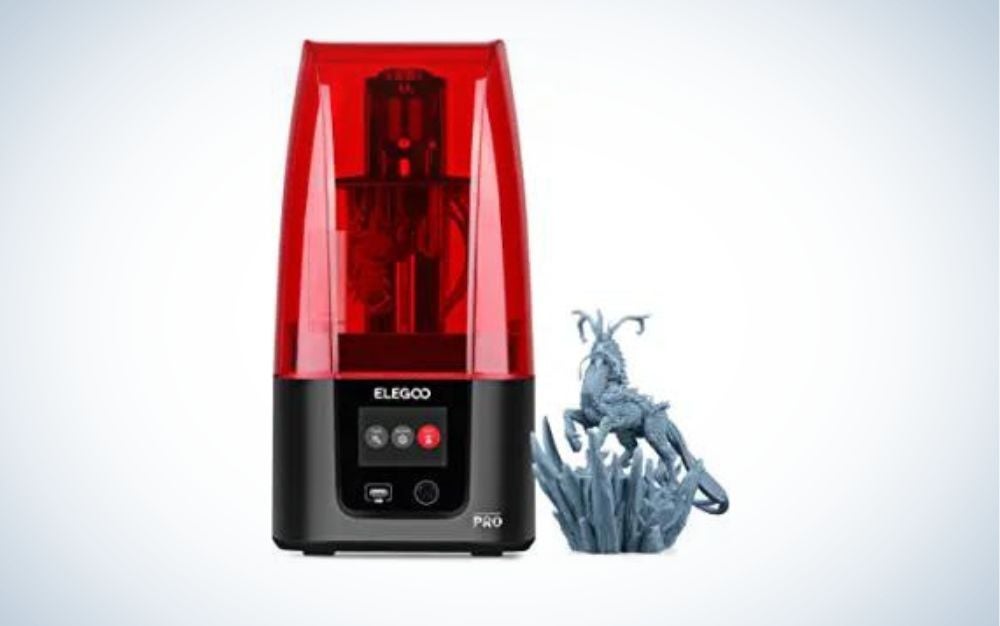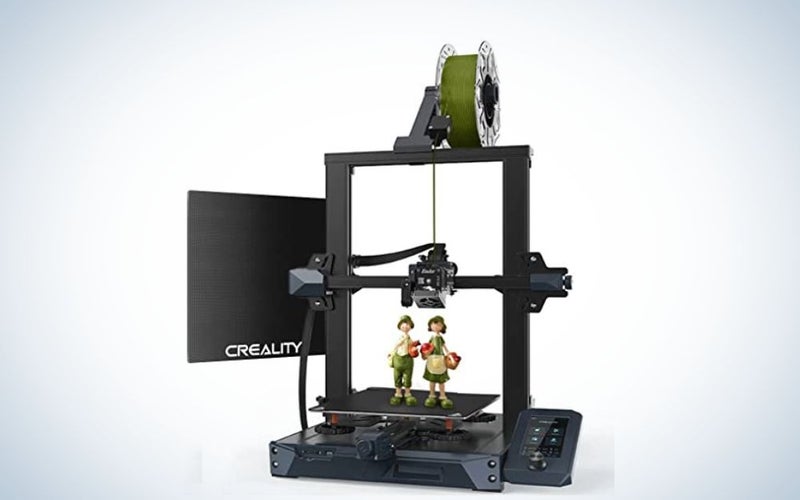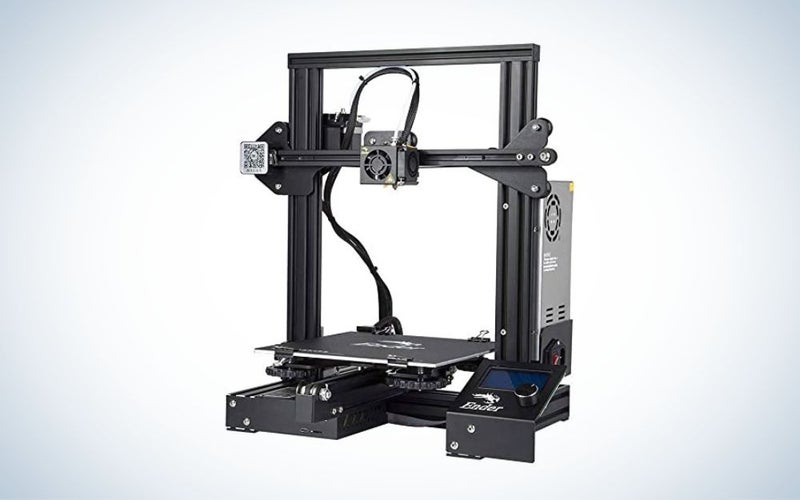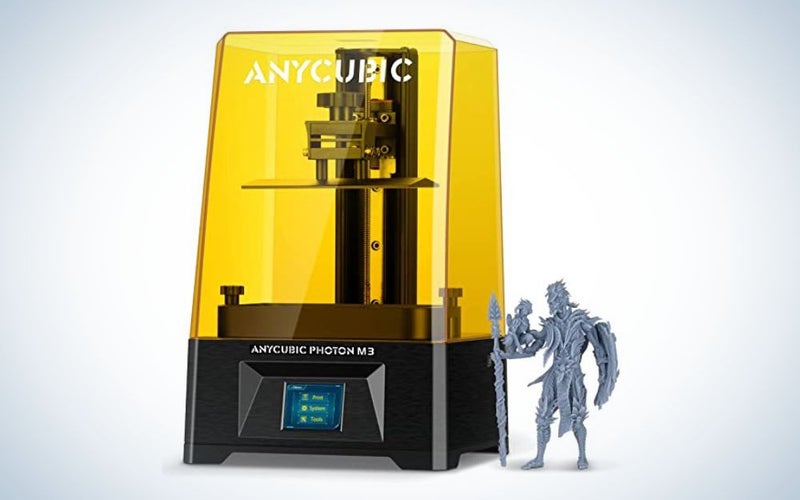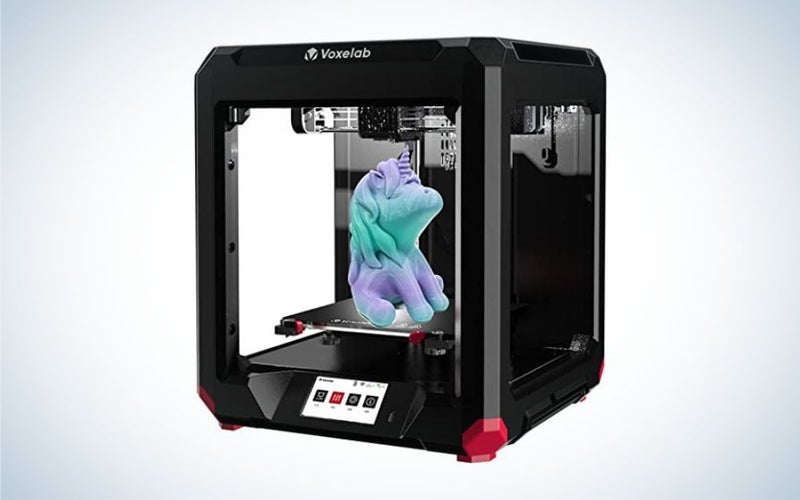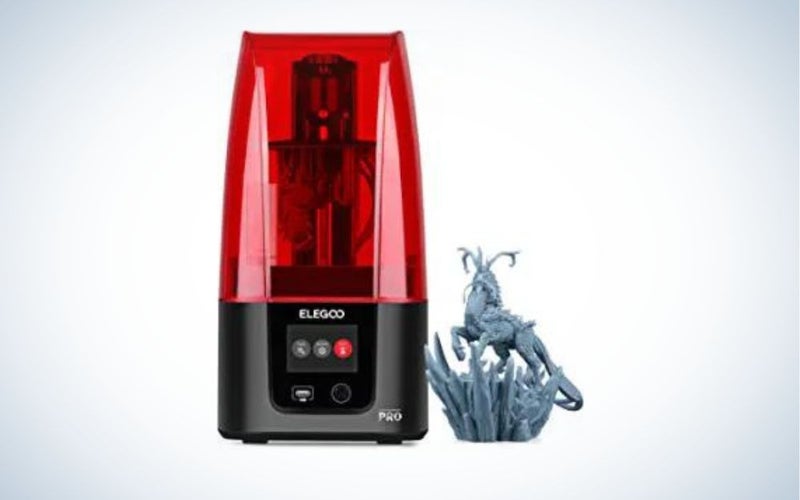We may earn revenue from the products available on this page and participate in affiliate programs. Learn more ›
Just a few years ago, 3D printers under $500 were simply toys. They weren’t very capable and they wasted more filament than they used correctly. That has changed in recent years, however, and now you can get a very capable machine for less than half a rack. You can even now buy great 3D printers for kids.
While there are (loosely) three main families of 3d printers out there, there are two which are widely available at the sub $500 price point. These are fused deposition modeling printers (FDM), which use thermoplastics in the form of filament, and stereolithographic printers (SLA), which use thermosetting plastics such as resin. Generally the more common FDM printers are better for larger projects, components, and prototyping, while SLA printers are better for intricate prints, figurines, and art pieces.
Maybe you’re after an FDM printer to prototype that perfect Hellboy mask to sell on your Etsy shop, or instead you might need an affordable SLA printer to craft a perfect rendering of the Drider Ranger Chief that will be causing havoc in your next D&D campaign. Either way the best 3d printers under $500 have the tools you need to get there.
- Best overall: Creality Ender 3 S1
- Best budget: Creality Ender-3
- Best resin: ANYCUBIC Photon M3
- Best for beginners: Voxelab Aries
- Best for home: ELEGOO Mars 3 Pro
How we chose the best 3D printers under $500
To ensure our list of the best 3d printers under $500 was as authoritative as possible, we researched numerous printers from leading manufacturers, diving deep into their specs and feature-sets and comparing them to the competition. We made sure to include a number of 3d printers for specific applications, including both SLA and FDM printers. Along the way we looked for a few specific criterias:
Versatility is always important in gadgets — especially those meant for creation. We prioritized printers that can handle more materials, and noted those that do a better job with this. On FDM models the temperature the extruder reaches is critical to this, and resultantly we noted max heat for each FDM. SLA printers also come with specific resin limitations, we also noted these.
Leveling is highly important, as a level print substrate makes for precise prints. We factored the leveling controls in all the printers we looked at. Where they included solid auto-leveling we highlighted it.
Print size defines the edges of your creative space. We noted the max print size of all the printers we featured, both in X and Y parameters as well as in Z.
Precision translates into fewer flaws and mistakes in your print. We looked for printers that are capable of high levels of precision, for smooth forms without lines or ridges.
Assembly can make or break a printer experience — especially for those who are new to the game. We looked at how difficult all of the printers we featured are to assemble, as well as how much maintenance is required to keep them printing.
The best 3D printers under $500: Reviews & Recommendations
Best overall: Creality Ender 3 S1
Comgrow
Why It Made The Cut: Versatile, easy to set up, and upgradeable, this super precise FDM is capable of printing with a decent amount of materials, and offers an all-around solid print cycle.
Specs:
- Print technology: FDM
- Size: 19.2 x 17.8 x 24.5
- Build size: 8.6 x 8.6 x 10.2 inches
- Supported materials: PLA, TPU, PETG, ABS
Pros
- Solid precision
- 16 point automatic leveling
- Supports multiple slicing softwares including Cura
- Easy assembly
- Easily modded for laser engraving with presets
Cons
- Loud prints
- Some of the instructions are confusing
Where FDM printers are concerned, the Creality Ender 3 series has to have some of the best name recognition around, and the Creality Ender 3 S1 exemplifies the qualities that made the brand so famous. At the sub $500 price point it really doesn’t get much better than this.
The S1 harnesses a few flawlessly designed features, and unifies them into a super-precise whole. The powerful extruder hits temps up to 500 degrees fahrenheit, and delivers a significant punch of pressure, even while it lightly moves across axes. It uses a geared Z-axis lift, with two motors. The system also offers an auto leveling bed. Altogether this means that the system is precise and versatile. It supports PLA, TPU, PETG, and ABS.
With a decent sized build space, a versatile list of materials supported, good precision, and an auto-leveling bed, the Ender 3 S1 is about as good as it gets at the sub $500 price point. It’s worth real consideration for anyone looking for a good fused deposition.
Best budget: Creality Ender-3
Comgrow
Why It Made The Cut: Probably the most famous starter 3d printer out there, this open sourced classic delivers lots of great basics, with a sensible design that’s easy to mod and expand on.
Specs:
- Print technology: FDM
- Size: 17.3 x 16.1 x 18.3 inches
- Build size: 8.7 x 8.7 x 9.8 inches
- Supported materials: PLA, TPU, ABS
Pros
- Easy to use
- Moddable
- Great community support
- Very affordable
Cons
- Requires manual leveling
- Noisy
- Assembly is involved and best use will require extra work
Released back in 2018, the Creality Ender-3 is to 3d printing what the Squier is to electric guitarists — ubiquitous, cheap, and trustworthy. The younger cousin to our best overall pick, the Ender-3 is a basic 3d printer that has everything most people need to get started, even if it’s missing some of the premium features and perfectly leveled components.
With a manual leveling tray that heats to 230 Fahrenheit, and a basic extruder that heats to 491 Fahrenheit, the Ender-3 might not be capable of dealing with the most advanced thermoplastics, but it’s certainly capable of handling the classics: PLA, TPU, and ABS, and even exceeds temps available in some higher-priced printers. It also sports a resume print function that will get it back online after interruptions, power outages, or filament shortages.
The main downside of this printer is its involved assembly. While it can be assembled in about two hours, the process isn’t easy, and print quality will be improved when extra time and care is spent on correcting for imperfections. That said, the printers vast community support in online forums and potential for moddability is one of its selling points, and the printer’s open-sourced DIY ethos is also one of its strongest assets. At the end of the day if you treat your Ender-3 as a 3d printer building kit, rather than just a 3d printer, it can give you everything you need, including some of the quiet, and comfort you’ll find in premium contemporary machines that are priced far higher.
Best resin: ANYCUBIC Photon M3
ANYCUBIC
Why It Made The Cut: This simple to use plug-in SLA printer delivers consistent detailed prints with zero system print-errors, and its deep community support makes for easy adoption and troubleshooting.
Specs:
- Print technology: SLA
- Size: 16.7 x 10.6 x 10.1 inches
- Build size: 7.1 x 6.4 x 4.0 inches
- Supported materials: Resin
Pros
- Extremely precise 4k LCD print
- LCD control screen
- Wide user base for support
- Decent build size for price
Cons
- Requires manual leveling
4k prints — they offer better resolution, smoother texture, and greater detail, and if you’re after a 4k 3d LCD printer for your home or workshop, you can’t do much better than the ANYCUBIC Photon M3. The Photon offers slightly larger print sizes than the ELEGOO Mars 3 Pro. It’s a budget printer from a line of 3d printers that includes some true premium tech.
The Photon M3 features a textured checkerboard build plate for better adhesion, and pairs this feature with a high contrast 4k screen. One of its standout features is a LCD control screen on the front, that allows for greater control of the device. Speaking of control, the printer allows for adjustable UV power that makes it compatible with a (somewhat) wider range of resins, but check the UV rating on your resin choice before you buy anyway to make sure it’s supported. Finally, it also features a UV-blocking cover that filters out harmful light from the LCD exposure process.
The Phonton M3 is a great choice for its deep user support network, excellent clarity, UV-blocking shield, and its controls with LCD panel. Whether it wins out over the ELEGOO is up to you, but its print quality is indisputably excellent for its moderate price.
Best for beginners: Voxelab Aries
Voxelab
Why It Made The Cut: Built for beginners, the Voxelab is a great place to start (and graduate), with a supremely easy setup, relatively-easy manual-leveling, wifi, and simple controls.
Specs:
- Print technology: FDM
- Size: 16.69 x 15.98 x 18.46 inches
- Build size: 7.9 x 7.9 x 7.9 inches
- Supported materials: PLA, ABS, PETG
Pros
- Easy auto-leveling
- Simple to control with Wifi
- Voxelmaker software allows control of multiple printers simultaneously
- Arrives assembled
Cons
- Leveling requires manual inputs
- Loud and annoying sounds
For those who might be experiencing a little trepidation about getting into the 3d printing game, the Voxelab Aries is an easy front runner to help you get settled and explore. The printer’s namesake Aries might be the Greek god of war, but the Voxelab capitalizes on simple harmony. With an open box appearance, this printer ships pre-assembled, and pre-loaded with PLA filament, offering near plug-and-play performance.
While the Aries doesn’t feature true auto-leveling, it does make it easy on you, with simple knob adjustment and a 3 point leveling system — this is why the company advertises the device as “semi-auto leveling.” With a max extruder temp of 482 Fahrenheit the printer is capable of printing PLA, ABS, and PETG. Its textured glass bed heats to 212 Fahrenheit for decent adhesion.
The real joy of this device is its simplicity and connectivity. The Aries uses Voxelmaker software that slices, and is capable of controlling multiple Voxelab printers. Setting adjustments are also easily configured via your computer. With its pre-assembled design, Wifi connectivity, and even 8 GB of internal memory, the Voxelab Aries is a great learners rig.
Best for home: ELEGOO Mars 3 Pro
ELEGOO
Why It Made The Cut: With exceptional resolution and detail, this SLA printer does wonders at detailed art prints.
Specs:
- Print technology: SLA
- Size: 8.93 x 8.93 x 17.28 inches
- Build size: 3.5 x 5.6 x 6.9 inches
- Supported materials: Resin
Pros
- High detail prints
- Consistent print quality
- 4k monochrome light
- Free Chitubox sample subscription
Cons
- Setup instructions aren’t the clearest
Resin prints offer resolution and detail that’s sure to wow anyone, whether it’s your Instagram followers cheering on your custom Warhammer figurines, or your mom when you print her that intricate new corn-cob skewer-set for the potluck. Whatever you’re printing, if it’s details that count, then you can’t do much better than the ELEGOO Mars 3 Pro.
This 4k monochrome printer offers an ultra-high-resolution, taking advantage of super dense chip-on-board integrated LCDs, this translates to greater detail with fewer mistakes. It features heat dissipation software that will improve its longevity, and also boasts an improved release film that elevates it above preceding models. With a one year subscription to Chitubox shipped with the device you’ll have access to powerful SLA print software that delivers all the basics, plus options that will take even experienced 3d printmakers into the weeds. If Chitubox isn’t your thing, the Mars 3 Pro also works with Lychee Slicer.
It’s when your Mars 3 Pro pairs with an ELEGOO Mini Air Purifier that it becomes a truly great kit for home use. Not many resin printer companies do as good of a job with air purifier accessories as ELEGOO, and it’s these types of health add-ons that can make your printer safe for use at home.
Related: Best 3D printers under $1000
Things to consider when shopping for the best 3D printers under $500
3D printers are inherently technical, and there’s a lot that goes into which one is right for you. These devices would have seemed like tech from “the future” in the 1950s or 60s. While 3D printers have gotten much more accessible in recent years, they’re still fairly complicated and involve a learning curve. Modern 3d printers link with your computer to slice 3d CAD models, process them, and then extrude the slices of the model into plastic (or another material), generating the model as a plastic form using one of a number of methods.
Bill Masters filed the first US patent for a 3d printer process, and his inspiration for the tech is actually a pretty useful metaphor for understanding its process. Laying on the banks of the Chattanooga river one night, he imagined a star as a seed point, then that adding more and more stars, you could make whatever shape you’d like. He has also likened 3d printing to shooting “spit wads” through a straw: “When you shoot a lot of wads, they begin to take shape. If you can control the direction of the wads and the motion of the device shooting them, you can produce any desired shape.”
Printer type
There are several popular 3D printing technologies out there, that range in capabilities from light prototype creation with simple thermoplastics like ABS, to high end SLS machines (and beyond) that can print in advanced materials such as nylons, medical grade polymers, metals, and more. Some hyper advanced systems are now even able to bioprint cells.
Constrained by a $500 dollar price point, this article will only focus on simple FDM and SLA printers. Entry level SLS printers generally cost thousands of dollars more. When you’re shopping, consider your print goals when you decide between an FDM and SLA model.
FDM Printers
FDM printers make up the lion’s share of the printers found on the market. They deposit melted filament at precise coordinates on a flat tray. FDM stands for fused deposition modeling, though these systems are also sometimes known by another term, fused filament fabrication (FFF). Much like a glue gun, thermoplastic filament is superheated through a nozzle and deposited onto X,Y, and Z coordinates on a leveled bed. Generally FDM printers are visually recognizable as printing “down,” in that a nozzle deposits plastic downward onto a bed. FDM printers do a good job with simple prototyping, proof-of-concepts, and less complicated economical prints.
SLA Printers
SLA, or stereolithography printers are capable of far more intricate detail, and use LED lights or lasers to cure liquid resin and extrude it from a liquid bath. SLA process is known as photopolymerization. Unlike FDM printers SLAs recognizably print “up,” as the model is extruded upwards (visually pulled) from the uncured liquid-state plastic bath. SLA printers do a great job with detail, high-resolution prints, and functional prototypes.
Thermoplastics
FDM printers use thermoplastics. These common plastics are able to melt, take shape, and melt again, much as water can be frozen into a shape, thawed, and frozen again, making them recyclable and reusable. Unlike water, a thermoplastic’s properties will change slightly as they are repeatedly melted. Some of the common thermoplastics used in FDM printers include ABS, PLA, PETG, and Nylon. Though not every printer will be able to service a wide range (especially at the under $500 range). These plastics often have useful properties, PLA is biodegradable, while PETG can be food safe, and nylon is safe for long term skin contact.
Thermoset Plastics
SLA printers use thermosetting plastics, or thermosets. These plastics cure to a solid form, and cannot be remelted and reused, rather they decompose with heat. These resins offer greater precision than most thermoplastics. Resins come in many forms, including clear resins, high-rigidity resins, and flexible resins.
Process
Your 3d printer will connect with your computer. To print, use a CAD modeling software to create a design, then slice it with the help of your printer software. Generally the software will then bounce the files out to your printer over your line connection or wireless connection. The printer can then begin work.
Post-processing
Some materials require post-processing. Often SLA prints will require an isopropyl alcohol wash to remove uncured resin before sanding and finishing. Other post-print processes help to strengthen or otherwise improve the properties of the materials your printer uses. There are specific post-processing machines that work well with specific materials.
FAQs
Q: What is a good 3D printer to start off with?
If you’re looking for a great 3D printer to start off with, you can’t do much better than the Voxelab Aries. Arriving pre-assembled and preloaded with filament (in select markets), the Voxelab also connects to your computer with Wifi and offers a simple slicing program, it’s a great budget starter for anyone looking to get into 3D printing.
Q: What is the most cost effective 3D printer?
The Creality Ender-3 is the most cost effective 3D printer. While many of its components are more basic than the competition, the Ender-3 has all the features you’ll need for solid 3D printing.
Q: Do all cheap 3D printers use PLA?
Not all cheap 3D printers use PLA, but the vast majority of filament based 3D printers do. There are two basic types of budget 3D printers, FDM and SLA. FDM printers use filaments, of which PLA is a common type. FDM printers use resin instead of filament, and won’t support PLA.
Q: Can 3D printers under $500 work with any software?
3D printers under $500 work with lots of software, but not all printers work with all software. Check the spec sheet on the printer you’re interested in to find out if it’s compatible with your preferred software.
Q: Are 3D printers under $500 good?
There are many 3D printers under $500 that are very good. The Creality Ender 3 S1 is the best overall.
Q: Which type of 3D printing is cheapest?
If you’re looking for the cheapest type of 3D printing, usually FDM printers are the most cost effective. While SLA resin printers can often be bought for around the same price as FDM filament printers, filament is generally somewhat cheaper over the long term.
Final thoughts on the best 3D printers under $500
When you invest in a 3d printer under $500, you invest in bringing your vision into physical form. These incredible devices extrude 3d prints from plastics with a few clicks of your mouse. Connect your SLA printer for detailed, high-resolution art prints, and strong prototypes with good rigidity. Plug in your FDM thermoplastic printer for large, affordable proof-of-concepts, or affordable accessories printed for your wardrobe. If you’re new to the game, the Voxelab Aries is the best option for beginners, coming pre-assembled and preloaded with filament, and offering easy Wifi connectivity with good controls. If you’re after exceptional detail for prints of figurines, or rigid prototypes, the ELEGOO Mars 3 Pro is an exceptional resin printer with excellent accuracy. If you want the most bang for your buck under $500, the Creality Ender 3 S1 is an amazing FDM printer that comes with some premium components such as an auto-leveler, and can be upgraded and modded into something that’s even more capable with a little work. Whatever you choose, expect great prints.
